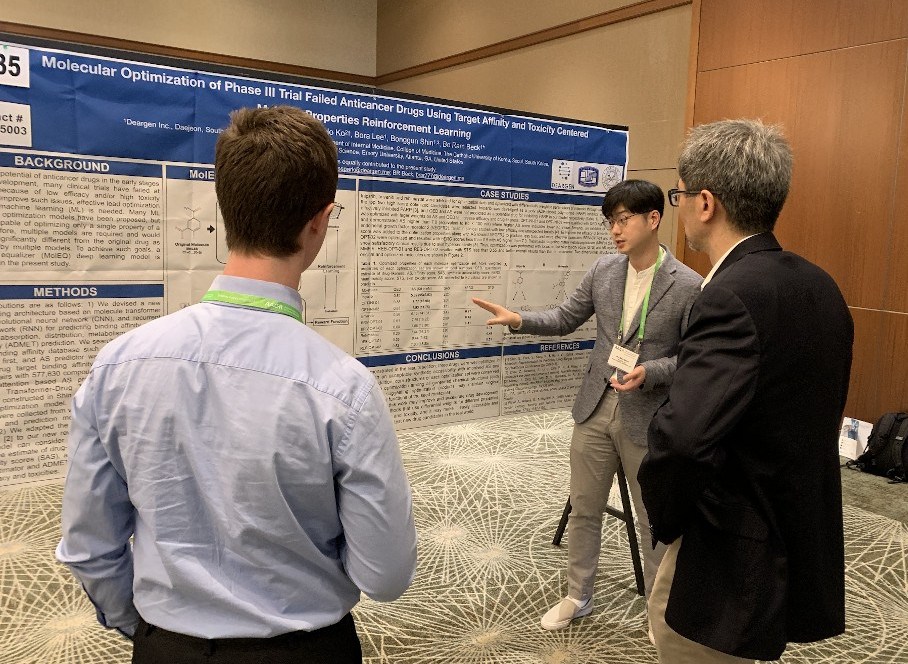MolEQ, an artificial intelligence model that adjusts multiple property at the same time and optimizes small-molecule lead compounds
Deargen Presented a novel small-molecule lead optimization model, MolEQ (Molecule Equalizer) at the AACR: Advancing Precision Medicine Drug Development : Incorporation of Real-World Data and Other Novel Strategies Special Conference, January 9 – 12, 2020.

Introduction
The lead optimization process is an important step in the first stage of drug development by modifying chemical structures and various properties such as efficacy, toxicity, and physical properties. This process is a very labor-intensive step as much as the hit compound discovery. A optimized lead compound could be a drug candidate after it has passed efficacy and safety evaluations. Therefore, lead optimization area is also where AI technology is highly demanded.
Background
There are many attempts to approach the lead compound optimization process with artificial intelligence technologies. Most models try to increase the drug similarity of a compound by focusing on one property of the drug such as Quantitative estimate of drug-likeness (QED). However, in this case, since the binding affinity, toxicity, and ADME (Absoprtion, Distribution, Metabolism, and Excretion) are not taken into account. Therefore, an optimization model with multiple property modulation is required. Finally, we present this model, MolEQ.
Methods
First, MolEQ is constructed on a module that predicts the drug-protein binding affinity based on molecule transformer (MT) [1], convolutional neural network (CNN), and recurrent neural network (RNN), a toxicity prediction module, and an ADME prediction module. Second, it uses a chemical structural manipulation model known as molecule deep Q-network (MolDQN) [2] (Figure 1).
In the MolEQ, the input seed molecule is modified to a variety of modified compound structures through four actions : element addition, element removal, bond addition and bond removal through the Markov decision process. The generated compound structures go through the evaluation process of MT-Drug-Target Interaction (DTI), DearADMET, and compound evaluation (QED, Synthetic accessibility, LogS, and etc.). When a reward function is given to the evaluated compound, it performs an iteration to modify the structure further through additional actions by reinforcement learning (RL, reinforcement learning) and presents the the optimized structures of generated compounds.
In this process, you can specify the weight of the part you want to place more weight on, such as affinity, ADME, toxicity, etc. and thereby give the direction of lead optimization to the model. The relevance of the evaluation module MT-DTI is well described in other articles (you can get more detail about MT-DTI through the button below).

Results
To test the model, we selected three anticancer drugs those failed phase III clinical trials. Iniparib was developed as a drug that inhibits poly (ADP-ribose) polymerase (PARP), but failed in the phase III clinical trial for the reason of low efficacy [3]. Therefore, we selected iniparib for a case of enhancing affinity.
In the case of brivanib, which inhibits Vascular endothelial growth factor recpetor 2 (VEGFR2), the toxicity was evaluated by DearADMET based on the FDA report [4] that reports low efficacy and unexpected toxicity. The result showed that brivanib has high hERG (cardiac toxicity) rate, so we selected brivanib as an optimization case to lower hERG values.
Finally, rebimastat is known to inhibit MMP9, but failed in the phase III clinical trial for the reason of skin toxicity [5]. We predicted property of rebimastat using DearADMET, and the result also showed high skin toxicity score. Therefore, the optimization was advanced to rebimastat with a focus on improving skin toxicity. Overall, we confirmed that the most important value for all drugs, affinity, was improved, and that the value of the problematic part for each drug was lower (Table 1).

As an example, if you look at the structure of the brivanib optimization results, you can see that the optimization was performed while maintaining the original core structure (Figure 2). Of course, if only the benzene ring is provided as a seed molecule, a new compound generation method can be applied. In the case of iniparib and rebimastat, generated compounds are significantly different from original core structure (results not provided: the results could not shown by intellectual property issues.).

In summary, we have found that the MolEQ model can provide direction for the optimization process as planned and is central to affinity. Even more surprising, we mentioned the optimization process, but also found that in many cases MolEQ almost can generate new compounds.
Conclusion
As shown above, the in silico optimization of the three clinical trial phase III failed drugs proceeded as intended. Moreover, one of the advantages is that by putting more weight on the synthetic accessibility, the actual synthesis can be made easier. We hopes that the use of MolEQ can accelerate drug development and reduce investment costs.
References
[1] Shin, B., Park, S., Kang, K., & Ho, J. C. (2019, October). Self-Attention Based Molecule Representation for Predicting Drug-Target Interaction. In Machine Learning for Healthcare Conference (pp. 230-248). [2] Zhou, Z., Kearnes, S., Li, L., Zare, R. N., & Riley, P. (2019). Optimization of molecules via deep reinforcement learning. Scientific reports, 9(1), 10752. [3] Mateo, J., Ong, M., Tan, D. S., Gonzalez, M. A., & De Bono, J. S. (2013). Appraising iniparib, the PARP inhibitor that never was—what must we learn?. Nature reviews Clinical oncology, 10(12), 688. [4] FDA. (2017). 22 Case studies where phase 2 and phase 3 trials had divergent results. [5] Winer, A., Adams, S., & Mignatti, P. (2018). Matrix metalloproteinase inhibitors in cancer therapy: turning past failures into future successes. Molecular cancer therapeutics, 17(6), 1147-1155.